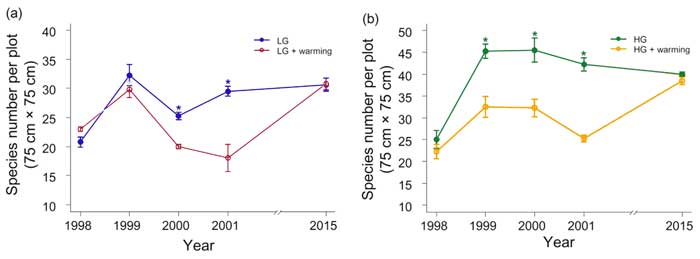| Follow @co2science |
Paper Reviewed
Zhang, C., Willis, C.G., Klein, J.A., Ma, Z., Li, J., Zhou, H. and Zhao, X. 2017. Recovery of plant species diversity during long-term experimental warming of a species-rich alpine meadow community on the Qinghai-Tibet plateau. Biological Conservation 213: 218-224.
In 1997, two field sites were established in alpine meadows at the Haibei Research Station (37.62°N, 101.20°E, 3200 m above sea level) in Haibei, Quinghai, China. Located approximately 1.5 km apart, one site had experienced a history of low grazing intensity (LG site) and the other one of high grazing intensity (HG site). At each of these locations, control and experimental plots were established to examine the impact of simulated warming (1-2°C above control plots) on plant species diversity.
After four years of warming, it was determined that warm plots lost an average of 11-19 species (~40%) relative to control plots (Klein, 2003; Klein et al., 2004). However, in a newly published paper, Zhang et al. (2017) contend that a four-year time period of examination is "too short to detect the role colonization and re-establishment may play in community re-assembly," as such processes are known to take place on the scale of decades and not years. Therefore, this newer team of seven researchers set out to resample the initial plots established at the Haibei Research Station after 18 years of simulated warming had passed, in order to see if the shorter-term findings of Klein (2003) and Klein et al. (2004) were indeed premature. And what did the extended analysis reveal?
As shown in the figure below, repeated sampling after nearly two decades revealed that the initial warming-induced decline in species diversity, in the words of the authors, "had rebounded to initial levels, on a par with control plots." And in light of this revelation, Zhang et al. conclude that "the long-term impacts of continued global warming are [likely] to result in highly dynamic processes of community reassembly and turnover that do not necessarily lead to a net decline in local diversity," adding that "short-term experiments may be insufficient to capture the temporal variability in community diversity and composition in response to climate change."

Figure 1. Effects of warming on species richness in (a) a site with a low grazing (LG) history and (b) a site with a high grazing (HG) history in 1998 to 2001, and 2015. Note the break in the x-axis between measurements made in 2001 and 2015. Error bars indicate ± SE and asterisks indicate significant differences (P < 0.05) between treatments based on standard t-tests. Adapted from Zhang et al. (2017).
References
Klein, J.A. 2003. Climate Warming and Pastoral Land Use Change: Implications for Carbon Cycling, Biodiversity and Rangeland Quality on the Northeastern Tibetan Plateau. PhD Thesis University of California, USA.
Klein, J.A., Harte, J. and Zhao, X.-Q. 2004. Experimental warming causes large and rapid species loss, dampened by simulated grazing, on the Tibetan Plateau. Ecology Letters 7: 1170-1179.
Posted 21 February 2018



